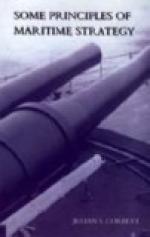While Rodney took the offensive area, Lord Howe was given the other. His task was to prevent the coalition obtaining such a command of home waters as would place our trade and coasts at their mercy, and it was not likely to prove a light one. We knew that the enemy’s plan was to combine their attack on the West Indies with an attempt to control the North Sea, and possibly the Straits of Dover, with a Dutch squadron of twelve to fifteen of the line, while a combined Franco-Spanish fleet of at least forty sail would occupy the mouth of the Channel. It was also possible that these two forces would endeavour to form a junction. In any case the object of the joint operations would be to paralyse our trade and annoy our coasts, and thereby force us to neglect the West Indian area and the two Spanish objectives, Minorca and Gibraltar. All told we had only about thirty of the line on the home station, and though a large proportion of these were three-deckers, a good many could not be ready for sea till the summer.
Inferior as was the available force, there was no thought of a purely passive defence. It would not meet the case. Something must be done to interfere with the offensive operations of the allies in the West Indies and against Gibraltar, or they would attain the object of their home campaign. It was resolved to effect this by minor counterstrokes on their line of communications to the utmost limit of our defensive reach. It would mean a considerable stretch of our concentration, but we were determined to do what we could to prevent reinforcements from reaching the West Indies from Brest, to intercept French trade as occasion offered, and, finally, at almost any risk to relieve Gibraltar.
In these conditions the defensive concentration was based on a central mass or reserve at Spithead, a squadron in the Downs to watch the Texel for the safety of the North Sea trade, and another to the westward to watch Brest and interrupt its transatlantic communications. Kempenfelt in command of the latter squadron had just shown what could be done by his great exploit of capturing Guichen’s convoy of military and naval stores for the West Indies. Early in the spring he was relieved by Barrington, who sailed on April 5th to resume the Ushant position. His instructions were not to fight a superior enemy unless in favourable circumstances, but to retire on Spithead. He was away three weeks, and returned with a French East India convoy with troops and stores, and two of the ships of-the-line which formed its escort.
Up to this time there had been no immediate sign of the great movement from the south. The Franco-Spanish fleet which had assembled at Cadiz was occupied ineffectually in trying to stop small reliefs reaching Gibraltar and in covering their own homeward-bound trade. The Dutch, however, were becoming active, and the season was approaching for our Baltic trade to come home. Ross in the North Sea had but four of the




